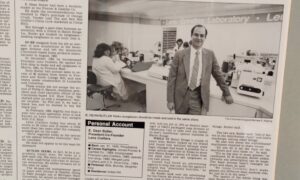By Michael Slusky, OD
How satisfied are patients with your practice? The net promoter score system willput that intoa number rating–and provide a guide to improve  your service. Best scenario, you will create advocatesfor your practice.
your service. Best scenario, you will create advocatesfor your practice.
Surveys and online reviews are valuable toolsto gauge how satisfied patients are with your practice. A powerful and insightful tool that I recommend is one that provides a Net Promoter Score (NPS).
The net promoter score test asks one simple question, “What is the likelihood that you would recommend a company to a friend or colleague?” This concept, which is utilized by various industries, was introduced by Frederick F.Reichheld of Bain & CompanyandSatmetrix, in the 2003 Harvard Business Review article, The One Number You Need to Grow.
The NPS is a method for organizations to learn more about their customers, with an emphasis to determine whether the products and services of the organization will create loyalty. I use the term loyalty to describe more than a satisfied experience; rather the creation of an “advocate” to promote the organization and generate new business through referrals. If you have recently taken a survey and found a question inquiring, “On a scale from 0 to 10, how likely are you to recommend the establishment…?” chances are that you just voted in on an NPS.
This information is of critical importance to an eyecare practice because we operate in a highly competitive and service-driven environment where we are increasingly challenged to differentiate one practice from another. Today, more than ever, the power of a personal recommendation–especially a candid recommendation from a peer–is paramount.
Be Prepared for Candid Comments
When our practice conducted an NPS poll, my greatest learning was a bittersweet message from a patient.He and his family felt that as an optometrist I was trustworthy and professional, and they wished to continue with me for their eyecare. However,my optical department and staff follow-through was not in alignment.
After identifying a low NPS, we contact the patient to learn about their concern, and try to find a resolution.Making direct contact made the experience personal and sincere for the patient. It also let me find the leak in the practice and repair it before more patients had the same problem.
The take-away for me was that any score lower than 9 deserves a personal follow up, by way of a telephone call or an email. Giving the patient a platform to speak their mind directly can change a negative into a positive. And importantly, you can deal with problems and dissatisfactions before they are permanently posted on a social media review site.
How to Determine Your NPS
You can derive your own NPS by polling a selection of your patient base. Ask them to rate your practice 0-10 on the question: “How likely are you to recommend this practice to a friend of colleague?”Their ratings fall into the following categories:
Detractor 0-6 rating
When someone rates a business0-6, they are referred to as a Detractor, and will not be a supportive voice for your business. Their opinion will not be favorable, and may appear as a negative social media review. Note that when a consumer has a bad experience, they share it with everyone.
Passive 7-8 rating
A rating of 7-8 may seem like a fair value and a comfort zone for those who may be of a modest disposition. People who rate at this level are known as Passives, and are indifferent to your practice. We may have been taught that modesty is best, but when it comes to growing your business, do not miss your opportunity to impress.
Promoter 9-10 rating
A Promoter rates a business 9-10. Promoters are the only ones who are likely to recommend a business to someone else. Note that a unique and positively differentiating experience may be shared with only a few friends or colleagues.
Now compute:From your patient responses, take the percentage of Promoters and subtract the percentage of Detractors. The result is your NPS.
High Net Promoter Score Correlates With Loyal Patients
NPS is a simplistic manner of inquiry that provides insight as to whether patients are loyal enough to refer the practice to others. Critics of NPS suggest that a single question may not be enough data to determine growth, but it provides a practice with the first step to investigate why their patients are not loyal to them.
Practices demonstrating a lower NPS can utilize additional survey questions to determine the area(s) of their practice that are falling behind and alienating their patients.
The flip side of a high NPS is used by a practice to identify and maximize their strength, and encourage practice growth through the strength of referrals. When you look at marketing dollars spent on advertising, the strength of a personal recommendation by word-of-mouth or social media is priceless. A practice with high NPS can use additional survey metrics specific to optometric care and optical aspects of the business to understand the specific areas of strength.
Additionally, survey questions can be added such as the quality and courtesy of care, office waiting time to see the optometrist and timeliness of product delivery, to name a few. Knowing what you are doing right is just as important as knowing your areas of needed improvement.
What Characteristics Do Practices With High Net Promoter Scores Have in Common?
The greatest strength behind the concept of NPS is to differentiate between satisfied and loyal patients. Satisfied patients represent individuals who received an expected level of products and service from your practice, and nothing more. This carries the risk of making the practice 100 percent replaceable by the next promotional coupon, change in insurance, internet purchase, or the recommendation made by a patient loyal to another practice.
We Fall Short on Comunications
Speaking with colleagues across the country, I’ve observed several common threads in strong, popular, growing practices. Our expanded scope of optometric care, blended with a variety of vision care devices we prescribe, may suggest that all practices are equal. One component that stands out and paves the way to growth is communication. The link between a higher NPS and growth is best achieved when the practice utilizes communication skills to first listen, understand, and then convey information to their patients that brings value to their specific individual “needs” and “wants.” A practice may have t state-of-the art diagnostic equipment,the finest eyewear, highest quality ophthalmic laboratory, and expert contact lens fitting skills. But do these attributes bring the patient value if they are not of interest or well understood by the patient?
Growing practices utilize these attributes to promote and differentiate themselves through their ability to communicate and bring value to the products and professional care they offer their patients. Taking no more than 30-60 seconds at the conclusion of a patient encounter and telling them what you prescribed, and why brings differentiating value to the patient encounter; and supports growth through building loyalty.
Low NPS: Steps to Take
When the patient assigns a lower NPS, the doctor/practice owner can recognize that there is a problem and isolate if it a service, product or a combination of both that is leaving their patients dissatisfied. Although it is difficult to point fingers at oneself, the practitioner can use this opportunity to identify the areas where their patients may be left disappointed.
Review staff greetings and first impressions: Common causes of a lower NPS include alack of ease in making an appointment, and the manner in which the office staff greets and engages patients on the phone and in the office. Bear in mind:First impressions are priceless.
Examine missed opportunities: Scrutinize all missed opportunities and empty promises. Is your staff following up on patient’s orders and stated delivery expectations? Other common causes of a low NPS:poor quality of eyewear craftsmanship, and failure to bring value to the patient’s product fees for eyewear..
Improve communication: Do you consistently provide good communication to patients regarding office policies on warranties, and utilization of patient’s vision care benefits, which tends to be uncharted territory? Failure to do so can result in a low NPS.
Reduce errors: Take ownership when errors occur, then follow through in the various areas of patient-practice encounters to reduce errors that would lead to patient dissatisfaction.
Relationship Between High Net Promoter Score and High Ratings on Yelp?
One can logically infer that a higher NPS score is proportional to a higher online Yelp status, but internet-based review sites such as Yelp use protective algorithms to discourage unfounded positive and negative reviews. Yelp users must first locate your practice on Yelp prior to reviewing your practice. Additionally, if they are not a frequent Yelper, the review may not post permanently online.
In conjunction to social media, optometrists with a high NPS (loyalty) can leverage their communication skills to encourage referrals by simply asking their patients to recommend them to their friends and family members who may be in need of care. One powerful example is a successful multifocal contact lens patient who is not using reading glasses at a dinner party.
Gain Control of Variables to Boost NPS
Setting a positive patient expectation may be the greatest secret to your success. A well constructed survey will help diagnose if the problem is on the vision care side (patient – OD encounter), product performance and service of its delivery, or both. When the patient assigns a lower NPS, the doctor/practice owner has recognized that there is a problem; additional survey questions covering the various patient-practice touch points can isolate where the practice failed to build a positive differentiating experience for the patient.
Today surveys are commonly found as post-visit e-mail notifications from organizations such as Survey Monkey, Web Systems 3, and ZocDoc to name a few.Generally speaking, the best survey results are the ones in which the business owner knew exactly what their client wanted, and how they wanted it delivered.Short of reading your patient’s minds, consider the variables of which you do and do not have direct control over. One can argue that a patient coming into your practice has formulated an opinion, and expectation; they may sometimes also be perceived as the “problem patient.” Many consider this patient to be a variable that they cannot control. I have been there myself, and learned from my dissatisfied patients.
Our system is now based on the principle of tipping uncontrolled variables toward our favor.A simple welcome and thank you e-mail or letter is a great way to gain control of unexpected variables by creating a positive expectation of which you have control. Creating a personal touch by simply letting the patient know what they can expect in the course of their visit to your practice. Look back to the opening sentence and the words that I used to get your attention; positive, expectation, greatest secret, and your success. These trigger words were intentionally placed in the opening of this paragraph create a positive value for you to continue reading, by addressing the thing that is really the most important, “What’s in it for me?” Changing your mindset that these people are really “patients with problems,” and recruiting them into your army of loyal practice advocates, gives you the ability to reduce the uncontrolled variables.
Hire a Third-Party Company to Communicate With and Survey Patients
There are companies that communicate with your patients on your behalf, which carry an added cost to your practice. An alternative is to employ a key individual to market your practice. Depending on the size of your practice, and your marketing budget, both options will serve the same purpose. A consideration when interviewing a company to deliver your surveys and maintain communications is to ask them how they handle bad reviews. Since you are employing this organization, you must be comfortable with the answer they give you regarding how much they support you. This has been my greatest lesson working with an organization that did not have our best interest in mind. If you choose to develop an internal practice marketer, professional appearance and dialogue, social media knowledge, and ability to work with others should be top requirements for this individual.
Encourage Patient Feedback
The greater the pool of positive reviews, the greater the chance of business growth. An optometric practice with 100 reviews appears more attractive as “tried and tested” than a practice with five reviews; but we all have to start somewhere. Encouraging positive reviews should go hand in hand with creating a valued patient experience.
Rewarding positive reviews gives you a competitive edge in lieu of leaving it to chance. Our office has sponsored various contests for patients to write about their experience with glasses, contacts, or the overall experience. Stories are judged and simple prizes such as coffee cards are given out.And our philosophy is that everyone who writes in is a winner.
Utilizing NPS surveys can uncover the underlying factors that drive business away, and create the opportunity to reclaim loyalty. Survey components can help identify if the service, products, trust or expectations were not met in the course of the patient’s visit. Utilizing this information, eyecare providers can rectify the problems, and shift emphasis on how to create practice Promoters.
Related ROB Articles
Patient Satisfaction Surveys: Measure Expectations, Then Exceed Them
Get 360-Feedback from Patients
Your Practice Improvement Guidepost: Patient Satisfaction Surveys
Michael Slusky, OD, is co-owner, along with wife Joanna Slusky, OD, of Halsted Eye Boutique in Chicago, Ill. To contact him: m.slusky@comcast.net



























